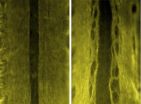(Press-News.org) Irvine, Calif., Dec. 19, 2012 — Most people are impressed by how a toad jumps. UC Irvine biologist Emanuel Azizi is more impressed by how one lands.
An assistant professor of ecology & evolutionary biology who specializes in muscle physiology and biomechanics, Azizi found that nature's favorite leapers possess a neuromuscular response that's specific to the intensity of a landing – a mechanism that protects muscles from injury upon impact.
The research is helping reveal how the nervous system modulates motor control patterns involved with jumping and landing. Azizi's findings on the underlying function of muscle control, he said, could one day improve rehabilitation programs for people with neuromuscular deficiencies.
In all vertebrates – from toads to humans – muscles contract to provide jumping power. Landing, however, requires that muscles stretch to dissipate energy and slow the body. But if muscles become overstretched during landing, injury can occur.
For a study appearing online today in Biology Letters, Azizi and UC Irvine graduate student Emily Abbott measured toads' muscular responses to leaps of different lengths. They discovered that during landing, toads' muscles adapt to the varying intensity of impact. As the creatures hop over longer distances, their landing muscles increasingly shorten in anticipation of larger impacts.
This pattern indicates that rapid and coordinated responses of the nervous system can act to protect muscles from injury, said Azizi, who added that future efforts will be aimed at understanding what sensory information is used to modulate these responses.
"Toads are ideal for studying jumping and landing because they're so good at it," he noted. "This work is providing the basic science on how muscles respond during high-impact behaviors like landing or falling."
###The research was funded by the National Science Foundation.
About the University of California, Irvine: Founded in 1965, UC Irvine is a top-ranked university dedicated to research, scholarship and community service. Led by Chancellor Michael Drake since 2005, UC Irvine is among the most dynamic campuses in the University of California system, with more than 28,000 undergraduate and graduate students, 1,100 faculty and 9,400 staff. Orange County's second-largest employer, UC Irvine contributes an annual economic impact of $4.3 billion. For more UC Irvine news, visit news.uci.edu.
News Radio: UC Irvine maintains on campus an ISDN line for conducting interviews with its faculty and experts. Use of this line is available for a fee to radio news programs/stations that wish to interview UC Irvine faculty and experts. Use of the ISDN line is subject to availability and approval by the university.
Contact:
Tom Vasich
949-824-6455
tmvasich@uci.edu
UC Irvine maintains an online directory of faculty available as experts to the media. To access, visit www.today.uci.edu/experts.
For UC Irvine breaking news, visit www.zotwire.uci.edu.
Obese, postmenopausal women are at greater risk for developing breast cancer and their cancers tend to be more aggressive than those in lean counterparts. A University of Colorado Cancer Center study published in the December issue of the journal Cancer Research shows how this risk might be prevented.
"By using nutrient tracers for fat and sugar, we tracked where the body stored excess calories. In lean models, excess fat and glucose were taken up by the liver, mammary and skeletal tissues. In obese models, excess fat and glucose were taken up by tumors, fueling their ...
Working with mice, Johns Hopkins scientists have discovered that a particular protein helps nerve cells extend themselves along the spinal cord during mammalian development. Their results shed light on the subset of muscular dystrophies that result from mutations in the gene that holds the code for the protein, called dystroglycan, and also show how the nerve and muscle failings of the degenerative diseases are related.
As mammals like mice and humans develop, nerve cells in the brain and spinal cord must form connections with themselves and with muscles to assure proper ...
Computer scientists at the University of California, San Diego have built a small fleet of portable pollution sensors that allow users to monitor air quality in real time on their smart phones. The sensors could be particularly useful to people suffering from chronic conditions, such as asthma, who need to avoid exposure to pollutants.
CitiSense is the only air-quality monitoring system capable of delivering real-time data to users' cell phones and home computers—at any time. Data from the sensors can also be used to estimate air quality throughout the area where the ...
For more than half a century, researchers have known that the bacteria that colonize the gastrointestinal tract of mammals influence their host's cholesterol metabolism. Now, Jens Walter and colleagues of the University of Nebraska show that changes in cholesterol metabolism induced by diet can alter the gut flora. The research was published online ahead of print in the journal Applied and Environmental Microbiology.
In the study, the researchers added plant sterol esters to the diets of hamsters. The overall effect of this was to inhibit several bacterial taxa, from ...
URBANA – Human immunodeficiency virus (HIV) may have affected humans for much longer than is currently believed. Alfred Roca, an assistant professor in the College of Agricultural, Consumer and Environmental Sciences at the University of Illinois, thinks that the genomes of an isolated West African human population provide important clues about how the disease has evolved.
HIV is thought to have originated from chimpanzees in central Africa that were infected with simian immunodeficiency virus (SIV), a retrovirus. "If you look at the diversity present across SIV in chimpanzees, ...
This fall, the Kavli Institute for Cosmological Physics at the University of Chicago and the National Academy of Sciences organized a colloquium that brought together more than 100 cosmologists, particle physicists and observational astrophysicists – three fields now united in the hunt to determine what is dark matter. Their goal: to take stock of the latest theories and findings about dark matter, assess just how close we are to detecting it and spark cross-disciplinary discussions and collaborations aimed at resolving the dark matter puzzle.
So where do things stand? ...
Hospital MRIs may be better at predicting long-term outcomes for people with mild traumatic brain injuries than CT scans, the standard technique for evaluating such injuries in the emergency room, according to a clinical trial led by researchers at the University of California, San Francisco (UCSF) and the San Francisco General Hospital and Trauma Center (SFGH).
Published this month in the journal Annals of Neurology, the study was led by UCSF neuroradiologist Esther Yuh, MD, PhD and followed 135 people treated for mild traumatic brain injuries over the past two years ...
PHILADELPHIA — The field of metamaterials involves augmenting materials with specially designed patterns, enabling those materials to manipulate electromagnetic waves and fields in previously impossible ways. Now, researchers from the University of Pennsylvania have come up with a theory for moving this phenomenon onto the quantum scale, laying out blueprints for materials where electrons have nearly zero effective mass.
Such materials could make for faster circuits with novel properties.
The work was conducted by Nader Engheta, the H. Nedwill Ramsey Professor of Electrical ...
December 18, 2012 -- Researchers in the Department of Health Policy and Management at Columbia's Mailman School of Public Health assessed the impact of pollution on agricultural worker productivity using daily variations in ozone levels. Their results show that ozone, even at levels below current air-quality standards in most parts of the world, has significant negative impacts on worker productivity. Their findings suggest that environmental protection is important for promoting economic growth and investing in human capital in contrast to its common portrayal as a tax ...
UNIVERSITY PARK, Pa. -- Brine water that flows back from gas wells in the Marcellus Shale region after hydraulic fracturing is many times more salty than seawater, with high contents of various elements, including radium and barium. The chemistry is consistent with brines formed during the Paleozoic era, a study by an undergraduate student and two professors in Penn State's Department of Geosciences found.
The study indicates that the brine flowback elements found in high levels in the late stages of hydraulic fracturing come from the ancient brines rather than from salts ...

